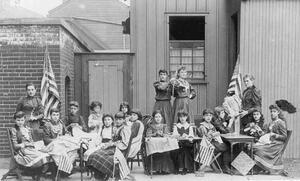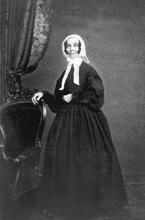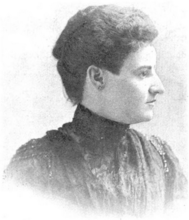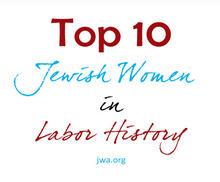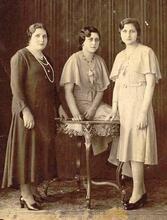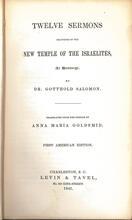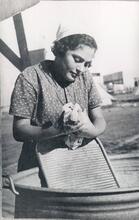Vocational Training Schools in the United States
In the years prior to World War I, few institutions enchanted the members of American Jewry’s philanthropic community as much as that “Aladdin’s lamp” of upward mobility, the vocational training school. Combining education with charity and moral uplift with sociology, the vocational school spread from coast to coast. These schools originally focused on teaching domestic skills, but many students pushed the schools to offer training in professions such as stenography and bookkeeping as well. Some people criticized technical schools for their lack of emphasis on Jewish culture, others disapproved of their strictly gendered structure. By the middle of the twentieth century, the critics had won out and Jewish women largely stopped going to technical schools in favor of high education.
Technical Schools
Beginning in the 1880s and continuing well into the 1930s, exemplars of “beautiful, clean, happy little technical school homes” took root everywhere, from Portland’s Industrial Sewing School and Cleveland’s Kitchen Garden School to New York’s Hebrew Technical School for Girls. “All the tendencies of the age are towards vocational school,” exclaimed the American Hebrew in 1915, noting how the possibility of making “happy and honored artists and artisans” out of what might otherwise have become “drudges and drones,” or worse still prostitutes and misfits, fired the collective imagination of the civic-minded.
For nearly fifty years, these institutions enabled immigrant women and their single daughters to aspire to, and in many instances actually attain, a higher standard of living. Ranging in scale from after-school programs and evening classes to a rigorous, uninterrupted eighteen-month course of study, “trade training” sought to outfit those women poised to enter the workforce with a set of marketable skills. All too many working girls, observed their great advocate Rose Sommerfeld, director of New York’s Clara De Hirsch Home for Working Girls, are “entirely unfitted to enter the great field of labor.” Inexperienced and unskilled, they “drift from one branch of industry to another, incapable of doing anything well.”
By providing women with a trade, be it dressmaking, millinery, or stenography, Jewish vocational schools sought to prevent “drift” while at the same time raising wages and generating self-reliance and independence. “Our aim,” explained the president of New York’s Hebrew Technical School for Girls, “is not merely to enable our girls ... to become self-supporting, but we are constantly trying...to dignify them, to refine them, to ennoble them.”
At first, institutions like the Hebrew Technical School for Girls concentrated their efforts on encouraging Jewish immigrant women to take up the broom and the dust rag. With cooks, laundresses, and housekeepers in short supply, a career in domestic service, explained educator Julia Richman, one of its most ardent champions, was of inestimable utility. It not only provided a secure job but also enabled young immigrant women to acquire “habits of greater refinement and culture. Table manners and personal habits will improve and with their improvement a long stride will have been taken away from the old landmarks of ignorance and vulgarity.”
Domestic Chores
More to the point, perhaps, the emphasis placed on domestic service reflected the belief that housekeeping had as much to do with moral order as with physical disorder. “Home is the foundation of society,” declared a leading social worker. “We will have better homes when every woman is trained to be a thoroughly competent cook, dressmaker, designer, milliner or whatever it may be, because through this training habits of industry will be developed which will make a finer type of character.”
Despite such lofty rhetoric, record numbers of Jewish students turned a deaf ear to claims that domestic service was truly a noble profession. Housework, they insisted, was a “wretched occupation,” too low-paying, too onerous and a brake on their independence.
“Did I come to America to make from myself a cook?” a character in Anzia Yezierska’s acclaimed short story “How I Found America—Part Two” exclaims, giving voice to the immigrant Jewish woman’s objections to working as a servant, objections widely noted both within and without the philanthropic world. “Almost without exception, [they] prefer the hard work combined with the freedom of the factory, to the easy toil of domestic service, which deprives them of liberty,” editorialized the American Hebrew, its sympathies more with the servantless mistress than with the working girl.
Like the newspaper, the philanthropic community appeared vexed, even irritated, by the lack of enthusiasm displayed by working girls for domestic service, which they interpreted as a show of arrogance and (unseemly) ambition. In time, however, its members conceded that their attempts to promote domestic service had completely failed. Many went a step farther, agreeing with Sadie American who, in 1911, wrote: “We can no more in these days undertake to make girls into servants because they are poor than we can undertake to make girls into beauties if the Lord has not built them that way. We have got to wake up to this.”
Eventually, social workers and educators did just that, abandoning their commitment to domestic service. What they did not abandon, however, was their fidelity to gendered notions of work or, as Minnie Louis, the founder of the Hebrew Technical School for Girls, would have it, the “effeminate employments.” Hailing the needle as “woman’s industrial sceptre,” Louis and her colleagues enthusiastically promoted sewing, dressmaking, and millinery as appropriate forms of female employment. As office work became increasingly respectable, even glamorous, instruction in stenography, bookkeeping, and the newfangled skill of typewriting was added to the curriculum.
Impact
In later years, beauty culture, yet another example of “effeminate employment,” was enthusiastically promoted as well. A growth industry in America of the 1920s, beauty culture, explained Samuel Turchin in his textbook Barbering and Beauty Culture, “is an occupation in which a trained person dresses the hair, manicures the fingernails, pedicures the toenails, and beautifies the face by mean of cosmetics. … A person in this occupation,” he went on to explain, “is often termed a hairdresser, dermatician or cosmetologist. However, the term most acceptable … is a beautician.” By whatever name, beauty culture took hold in the classroom. Drafting tables made way for emery boards as students were now encouraged to meet the “growing demands of beautification” by studying its secrets.
For all their concern with the workplace, Jewish vocational schools firmly believed that working women ought not to be “mere adjuncts of machinery” but ladies who worked or, as the president of one such school put it, “wage-earners with an appetite—indeed a hunger—for intellectual advancement.” To whet that appetite and, in the process, to “implant in the character all the elements that go to make up the perfect woman,” students were taught penmanship and “personality,” music, geography, hygiene, and “housewifely wisdom.” They were also actively encouraged to get out from behind the workbench and the desk to experience the finer things in life: Trips or self-styled “pilgrimages” to museums and concerts, day-long outings to the country, and opportunities to “meet and mingle with those more favored” filled the days of the female Jewish vocational student.
An estimable success, the Jewish vocational training movement quickly took hold. “What a boon!” exclaimed one observer as early as 1907, noting its contribution to America’s urban economy. Hundreds of girls “annually to enter [the] labyrinths of labor bringing the standard of ability, purity and aspiring womanhood.” Louis couldn’t agree more. “Already is the change fast coming,” she related. “Dainty, alert, intelligent, earnest Jewesses sit at the bookkeeper’s desk and at the typewriter’s machine.” Well trained and well mannered, her students and those of sister institutions had little trouble securing positions and were often sought by manufacturers. “When I finished my education,” recalled one alumna of the Hebrew Technical School for Girls, “I got a job. Very easily, because people used to call up Hebrew Tech to ask for their girls, because they knew how bright we were.”
Criticism and Legacy
Still, the enterprise was not without its critics. Some, like Henrietta Szold, writing in 1903, wondered why practical skills were taught at the expense of Jewish cultural literacy. The “salvation of Jewish girls as Jewesses and, for the present at least, as fine specimens of womanhood, depends upon a proper alignment of their Jewish education with their secular education,” she counseled, but to little avail. A generation later, officials of New York’s Federation of Jewish Philanthropies, investigating conditions at the Hebrew Technical School for Girls, put forth much the same claim. “It seems strange,” they declared, “that a school that recruits its student body exclusively from Jewish homes should do absolutely nothing to acquaint these girls with the basic tenets of Jewish faith and with the most dramatic incidents and characters of the Old Testament and of Jewish history.”
Still other critics, like the redoubtable Sadie American, questioned both the meaning and the efficacy of thinking about work in rigidly gendered terms. “But all girls no more like to sew and are no more fitted to sew than boys like to be sailors. It is a curious thing,” she added, “that the world has classified all women together, not realizing that they [are] made differently just as men are.”
Ahead of her time, Sadie American would ultimately be proved right. By the 1940s, increasing numbers of American Jewish women, many the daughters of vocational school alumnae, set their sights on higher education. Enrolling in college rather than a technical school, a new generation of Jewish women began to expand its horizons. Concomitantly, the world of the Jewish technical school began to contract. Meanwhile, increased competition from the public sector, which, by the 1920s, had actively committed itself to building a network of vocational high schools, exacerbated matters, forcing many private Jewish facilities to acknowledge that they had “outlived their usefulness.”
In the end, the Jewish vocational movement was a victim of its own success. Enabling thousands of “aspiring” women to make good, it placed within reach the promise of America.
Annual Report, Hebrew Technical School for Girls, 1900–1919.
Joselit, Jenna Weissman. Aspiring Women: A History of the Jewish Foundation for Education of Women (1996).
Richman, Julia. “Women Wage Earners.” Papers of the Jewish Women’s Congress (1894).
Szold, Henrietta. “The Education of the Jewish Girl.” The Maccabaean 5, no 1 (July 1903): 8–10.

